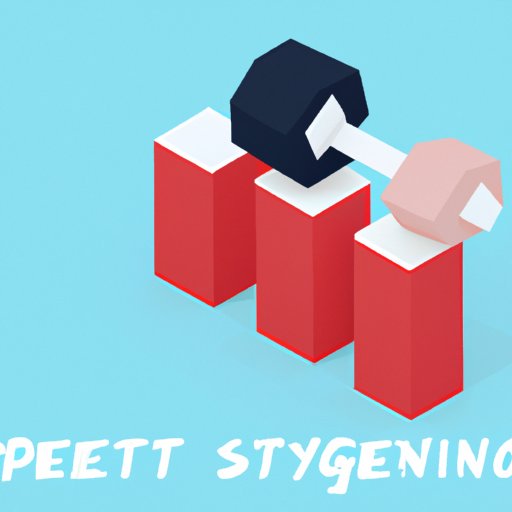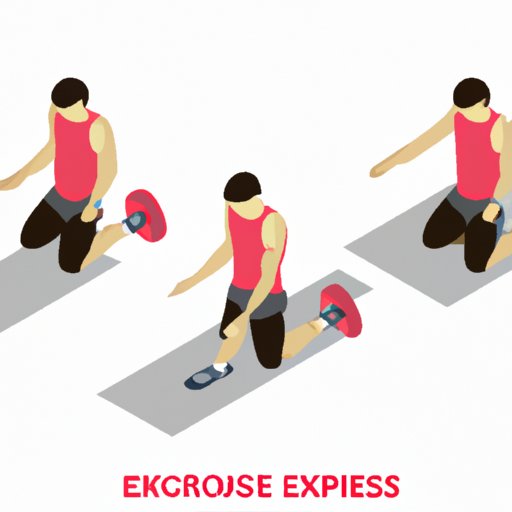Introduction
Isometric exercise is a form of strength training that involves contracting muscles without movement. Unlike traditional exercises that rely on repetitive motion, isometric exercises involve holding a position for an extended period of time. With this technique, you can build strength, improve endurance, and even alleviate joint pain – all without equipment or leaving the comfort of your home. In this article, we’ll explore everything you need to know about isometric exercise, from benefits to techniques and tips for incorporating them into your workout routine.
The Ultimate Guide to Isometric Exercise: From Benefits to Techniques
Before diving into how isometric exercise works, let’s take a look at its benefits over other forms of exercise. Isometric exercises can:
- Build strength quickly: You can see significant progress in a short period of time with isometric exercises. Holding a position puts your muscles under tension, which leads to increased strength.
- Improve endurance: Isometric exercises can help you build endurance by working your muscles in a way that other exercises do not. By holding a position, your muscles experience increased tension for a longer period of time, which builds endurance and resistance to fatigue.
- Burn fat: Isometric exercises can help you burn fat by increasing your heart rate and requiring your body to use energy to maintain the position.
- Reduce the risk of injury: Because isometric exercises don’t involve movement, they can be performed with little to no risk of joint pain or injury.
Isometric exercises differ from other forms of exercise because of how they target the muscles. Other forms of exercise like weight lifting or cardio involve pushing or pulling movements, while isometric exercises involve holding one position for an extended period of time. By holding a position, your muscles experience increased tension, which leads to growth and strength development.
Popular isometric exercises include the plank, wall sit, and glute bridge. These exercises can be incorporated into your routine and tailored to your fitness level. Here are some tips for incorporating isometric exercises into your routine:
- Start small: Begin with shorter holds and fewer repetitions to avoid injuring yourself.
- Increase time: As you become comfortable with an exercise, increase the amount of time you hold the position.
- Increase difficulty: Make an exercise more difficult by changing the position, adding weight, or reducing your support.
- Stay consistent: To see the benefits of isometric exercise, you need to keep up with a consistent routine that trains your muscles and helps you progress.
Get Fit Anywhere with Isometric Exercise: No Equipment Needed
The best part of isometric exercises is that they don’t require equipment or a gym membership. You can perform many exercises at home and add them to your workout without a gym. Here are some examples of exercises that can be done at home:
- Wall sit: This isometric exercise targets your lower body by holding a squat position against a wall. It requires no equipment and minimal space.
- Plank: The plank is an exercise that strengthens the core muscles and can be done anywhere without any equipment.
- Glute bridge: This is an effective exercise that targets your glutes, hamstrings, and core muscles. All you need is a mat or towel to support your back as you lift your hips off the ground.
Aside from the convenience, there are many benefits to doing isometric exercises at home. You don’t have to worry about gym fees, expensive equipment or wasting time traveling, and you can focus on building strength and endurance without judgement or distractions.

Boost Your Strength and Endurance with Isometric Exercise
Isometric exercise is a powerful tool for building strength and endurance. By holding a position for an extended period of time, your muscles experience increased tension, which leads to strength development. The longer you hold a position, the more tension your muscles experience, which leads to increased endurance and the ability to resist fatigue.
One of the benefits of isometric exercises is that you can easily measure progress. You can track how long you can hold a position and increase the duration over time. As you progress, you can increase the difficulty of the exercise to further challenge your body. Here are some tips for increasing difficulty as your strength and endurance improve:
- Change the position: By adjusting the position slightly, you can challenge different muscles and increase your overall strength.
- Add weight: By adding weight, you can increase the resistance, which leads to increased muscle tension and growth.
- Reduce support: By reducing your support, you can increase the difficulty of the exercise and further challenge your muscles.
Isometric Exercise: The Secret to Building Lean Muscle Mass
If you’re looking to build lean muscle mass, isometric exercise can help you achieve your goal. When you hold a position for an extended period of time, it creates tension in your muscles, which promotes growth and strength development. The longer you hold a position, the more tension your muscles experience, which leads to increased muscle mass.
To tailor your exercises for muscle building, you need to focus on holding a position for a longer duration. You can also increase the difficulty of the exercise by adding weight or reducing your support. Here are some tips for avoiding muscle imbalances:
- Work both sides equally: Make sure you perform exercises on each side of your body to avoid muscle imbalances.
- Stretch: Stretching before and after your workout can help reduce the risk of injury and maintain flexibility in your muscles.
- Rest and recover: Give your muscles time to rest and recover between workouts to avoid overuse and injury.
Say Goodbye to Joint Pain with Low-Impact Isometric Exercise
Isometric exercise is a low-impact workout that can be used to alleviate joint pain. Because isometric exercises don’t require movement, they can be performed with little to no risk of joint pain or injury. By holding a position for an extended period of time, your muscles experience increased tension, which can help to reduce pressure on your joints.
Here are some examples of exercises that can be used to alleviate joint pain:
- Plank: The plank is a great exercise for reducing joint pain because it targets your core muscles without impact.
- Wall sit: This isometric exercise can be used to reduce pressure on your knees by holding a squat position without the impact of jumping.
- Bridge: The bridge is an effective exercise that targets your back, glutes, and hamstrings without any impact on your joints.
Low-impact exercise is beneficial for people with joint pain because it can maintain muscle strength, increase flexibility, and improve overall joint stability.
Isometric Exercise for Weight Loss: How this Underestimated Technique Works
Isometric exercises can contribute to weight loss by increasing your heart rate and requiring your body to use energy to maintain the position. By increasing your heart rate, isometric exercises can help you burn fat and lose weight.
If weight loss is your goal, try incorporating isometric exercises into your workout routine. Here are some tips for getting started:
- Mix it up: Incorporate a variety of isometric exercises into your routine to keep it interesting and challenging.
- Start small: Begin with shorter holds and fewer repetitions to avoid injuring yourself.
- Increase time: As you become comfortable with an exercise, increase the amount of time you hold the position.
- Stay consistent: To see the benefits of isometric exercise for weight loss, you need to maintain a consistent routine that challenges your body and helps you progress.
Another benefit of isometric exercise for weight loss is that it can help you maintain your weight loss. By building strength and endurance, you can burn more calories, which can help you maintain a healthy weight long-term.
From Yoga to Bodybuilding: How Isometric Exercise Suits Every Fitness Level
One of the benefits of isometric exercise is that it can be adapted to different fitness levels, from beginners to advanced levels. Whether you’re new to fitness or an experienced bodybuilder, isometric exercises can be modified to fit your level of fitness.
Beginners should start with shorter holds and fewer repetitions, while those with more experience can increase the difficulty of the exercise. Here are some tips for modifying exercises for different fitness levels:
- Make it easier: You can make an exercise easier by reducing the duration of the hold, changing the position, or increasing your support.
- Make it harder: To increase the difficulty of an exercise, you can hold the position for a longer duration, add weight, or reduce your support.
- Stay consistent: To see results, maintain a consistent routine and challenge your body continuously.
Isometric exercise has benefits for beginners, intermediate, and advanced fitness levels. It can help you build strength, endurance, and muscle mass, all without risking injury or leaving the comfort of your home.
Conclusion
Isometric exercise is a powerful tool for building strength, endurance, and muscle mass. By incorporating isometric exercises into your routine, you can improve your fitness level and contribute to weight loss. The best part of isometric exercises is that you can do them anywhere, anytime, without any equipment.
Whether you’re a beginner or an experienced fitness enthusiast, isometric exercises can be adapted to fit your level of fitness. Start small, stay consistent, and track your progress to see the benefits of isometric exercise for yourself.
